This past week, while my boys were on their winter break from school, I finally found the time to visit one of the Washington, DC-area museums I’ve been anxious to see since moving up here – the National Museum of the U.S. Navy. Located next to the Anacostia River, inside the Washington Navy Yard, the Navy Museum is a good bit smaller than its sister facility, the National Museum of the U.S. Marine Corps, located in Quantico, Virginia. However, it is densely packed with artifacts and displays, many of them one-of-a-kind, and a naval buff can easily spend an entire afternoon strolling among the outside artifacts and exploring the various exhibits inside the museum hall. Additionally, the 1950s-era destroyer USS Barry is docked adjacent to the hall as a museum ship (the boys and I ran out of time and energy before setting foot aboard the Barry, so we’ll have to save that exploration for another visit to the Navy Yard).
We visited on a cold, blustery day, but the outside artifacts were so fascinating that we spent nearly an hour braving the winds off the river. Some of the most fascinating things we saw included:
Four cannons removed from the ironclad USS Tennessee (formerly CSS Tennessee) prior to that ship’s scrapping in 1867: two 7” Brook rifles and two 6.4” Brook rifles (the latter seen in the photograph of the Navy Museum’s entrance); as the CSS Tennessee, the ironclad had fought valiantly against Union Admiral David Farrugut’s entire fleet, which included four ironclad monitors, before being overwhelmed by the combined gunfire of the monitors USS Manhattan, USS Chickasaw, and USS Winnebago;
A 6” gun salvaged from the wreckage of the second class battleship USS Maine after she was sunk by a magazine explosion in Havana Harbor in 1898, the incident that precipitated the Spanish American War;
Several very large cannons which were never used in combat, including an experimental model of a 15” muzzle-loading cannon built in the 1850s, and a 16” gun built prior to the Washington Naval Conference arms limitations talks of 1921-22, which resulted in the scrapping, cancellation, or (in the cases of the USS Lexington and USS Saratoga) conversion of big gun capital ships into aircraft carriers; battleship size was limited by the treaty to 35,000 tons, which ruled out two classes of U.S. battleships and battlecruisers than being built, most of which would have been armed with the model of 16” gun on display here;
Sections of battleship armor plating, including large strakes of 16″ thick waterline armor and 9″ thick upper side armor from the USS South Dakota, plus a massive 26″ thick plate intended for the battleship Yamato, recovered by the American Navy at the Japanese naval base of Kure after the war and later tested against 16″ gun armor-piercing shells (as you can see, the American battleship gunfire pierced the Japanese plate clear through, so perhaps the American Iowa class battleships would not have been so terribly outgunned by the Yamato and Musashi had the ships ever met in a gun duel, particularly given the former ships’ five knots greater speed).
The most mesmerizing artifact we saw outside the museum was also the largest — a 14″ battleship gun mounted on a railcar carriage. This particular gun (identical to those being mounted on battle wagons of the Pennsylvania class) was shipped to France in the spring of 1918 in time to fire several hundred giant shells at German positions up to twenty-four miles distant. The gun was manned by U.S. Navy sailors who fired it in over a dozen campaigns on the Western Front.
Next in Part 2: the scale model treasures found inside the museum hall

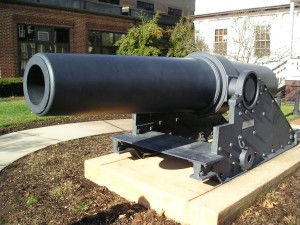
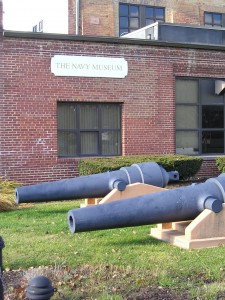
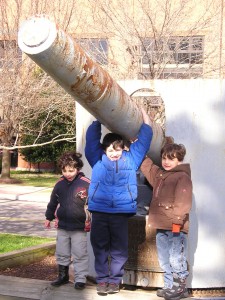
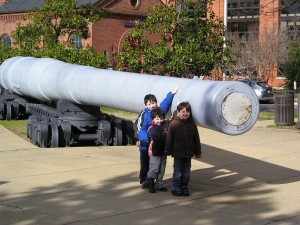
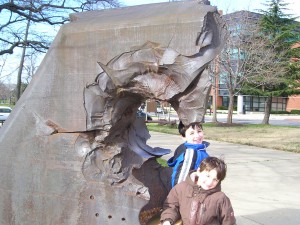
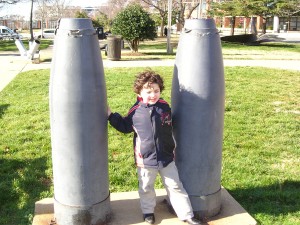
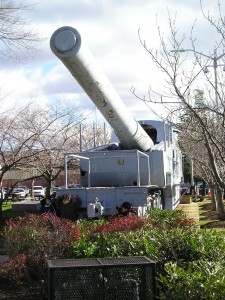
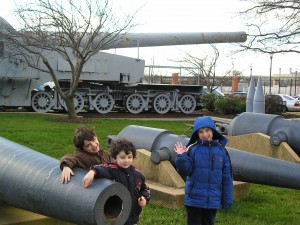




My favorite hangout as a kid, next to the Hall of Dinosaurs at the Smithsonian.
Of course, having a father who was a serving officer in the Navy may have caused a certain bias on my part.
Thanks for visiting! Please come back for part 2, which I plan to post tomorrow (lots of photos of the wonderful scale models inside the museum… they had me almost jumping up and down with excitement, they were so gorgeous…)